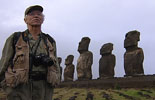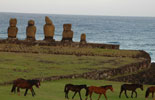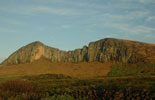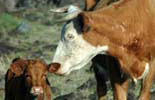 |
 |
 |
Chile
Rapa Nui, or Easter Island, has been politically Chilean since the late 19th century. Its ancient legacy of ecological disarray offers a message to humanity that transcends political boundaries. DSF went to Rapa Nui to chronicle that story for "Hotspots". There DSF filmed the last few remaining endemic species (a tree and a skink) and paid homage to the environmental restoration efforts underway by both students on the island and by the Chilean Forest Service.
Easter Island resonates as a symbol of the human species gone awry and bears searing relevancy for the 21st century. Nearly one hundred percent of what once existed on Rapa Nui is gone - including parrot species, at least twenty-one species of native trees, huge seabird diversity and abundance. Today the last remaining indigenous tree is restricted to just a few individuals - Sophora toromiro.
What was once paradise for the first Polynesian immigrants arriving by open canoe after weeks and weeks crossing wild seas, is today a bleak yet oddly beautiful place. One of the great cultural sites on Earth, hosting the huge stone Moais - statuary relics of a civilization that nearly vanished, on this largely denuded, depauparate island – Rapa Nui is also home to a contemporary renaissance, wherein the more than 3000 locals are attempting something of a poignant ecological redemption. Local traditions, language, music and custom, are thriving; and students are engaged, as is the forest service, in wide-scale ecological restoration, with at least sixteen native plant species being reintroduced.
Rather than viewing Rapa Nui as a failure, in the film "Hotspots" DSF views it as both a cautionary tale and an opportunity to learn, from the past and move forward armed with news tools, new wisdom, new paradigms for the future of safeguarding life on earth.
 |
 |
|
 |
 |

